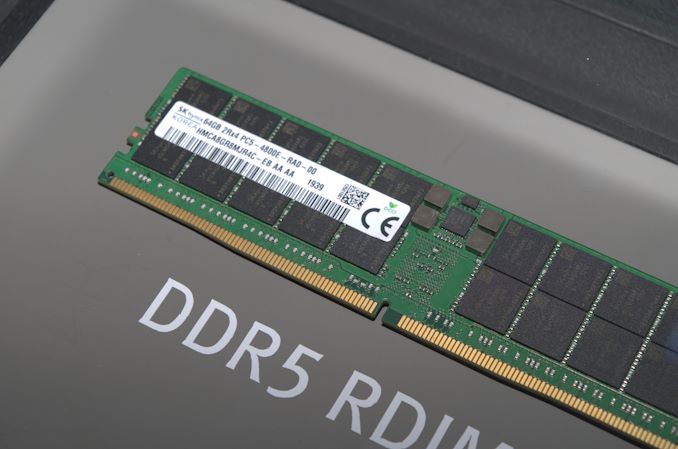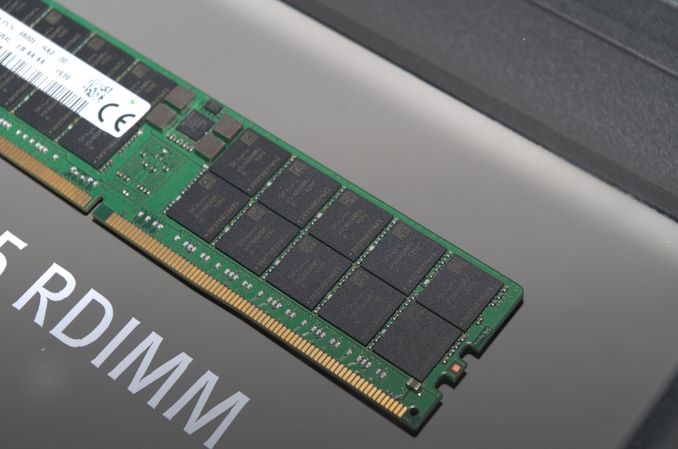Here's Some DDR5-4800: Hands-On First Look at Next Gen DRAM
by Anton Shilov on January 13, 2020 5:00 PM EST
Just like all major makers of DRAM, SK Hynix produced its first DDR5 memory chips a couple of years ago and has been experimenting with the technology since then. To that end, it is not surprising that the company displayed its DDR5 RDIMM at CES 2020, which implies that development is proceeding as planned.
At the trade show, SK Hynix demonstrated its 64 GB DDR5 RDIMM with ECC rated for a 4800 MT/sec/pin data transfer rate. The module marked as HMCA8GR8MJR4C-EB carries 20 memory chips marked as H5CNAG4NMJ as well as IDT’s P8900-Z2 register clock driver (RCD). The memory devices are marked differently than the ones SK Hynix used for 16 GB RDIMM back in late 2018, though we do not know the difference.
The DDR5 RDIMMS feature 288 pins on a slightly curved edge connector (to reduce the insertion force on every pin), just like DDR4 modules, yet its layout and design are a bit different when compared to DDR4 to prevent installment of DDR5 modules into DDR4 slots and vice versa.
It is unknown whether SK Hynix has already started to sample its DDR5 RDIMMs with developers of server platforms and servers, but it is obvious that all DRAM makers are aligning their DDR5 production schedules with CPU designers and other companies.
At present, it is unclear when exactly the first DDR5 platforms are set to hit the market, but a good guess would be 2021. One of the first platforms to confirm support for DDR5 memory has been Intel's Xeon Sapphire Rapids, set for deployment in the Aurora Supercomputer. AMD support for DDR5 is unknown so far.
Related Reading:
- CES 2020: Micron Begins to Sample DDR5 RDIMMs with Server Partners
- SK Hynix Details DDR5-6400
- SK Hynix Develops First 16 Gb DDR5-5200 Memory Chip, Demos DDR5 RDIMM
- Cadence & Micron DDR5 Update: 16 Gb Chips on Track for 2019
- Cadence and Micron Demo DDR5-4400 IMC and Memory, Due in 2019
- JEDEC: DDR5 to Double Bandwidth Over DDR4, NVDIMM-P Specification Due Next Year
Source: SK Hynix












38 Comments
View All Comments
Santoval - Monday, January 13, 2020 - link
"AMD support for DDR5 is unknown so far."While it is still unknown, the best guess would be 2021 as well. Zen 3 will apparently be the last AM4 socket Ryzen, and will be released in mid-late 2020. To support DDR5 AMD almost certainly need to change the CPU socket, and 2020 is too early anyway. So that leaves Zen 4 based Ryzen CPUs, which will require a new socket that will also support DDR5.
One either option is early DDR5 support just for Zen 3 based Epyc server CPUs. Since AMD moved the DRAM controllers to an I/O die perhaps they could do that without requiring new chiplets just for Epyc. The problem AMD has with their server line is that they keep increasing the number of cores but the memory controllers have been limited to 8, so with each generation more cores compete for the same memory access.
If they increase the cores of Zen 3 based Epyc CPUs further without DDR5 they might need to increase the memory channels to 12, and I doubt they would do that for just one server generation. So a way out would be early DDR5 support. Or no core increase. Q3/Q4 2020 might be too early for DDR5, even for servers. So they will either opt for no core increase or add one more chiplet pair for 80 cores while increasing the L3 cache and the supported DDR4 frequency further to compensate.
eek2121 - Monday, January 13, 2020 - link
I mean, Ryzen 5000 series on 5nm with DDR5 and PCIE5 on 5/5 makes complete and total marketing sense. ;)AshlayW - Tuesday, January 14, 2020 - link
AM5 :DAshlayW - Tuesday, January 14, 2020 - link
5 cores, 5 threads @ 5 GHz?Too far? Yeah, because that would actually suck for my workloads vs even my 2700 @ 3.3 lol
nandnandnand - Tuesday, January 14, 2020 - link
If you want a 5-core, get that Lakefield chip with the big/small cores.I'm not sure about frequency, but Zen 4 should be good if both Zen 3 and Zen 4 bump up frequencies.
ksec - Monday, January 13, 2020 - link
Where are the 128 and 256GB DRAM?